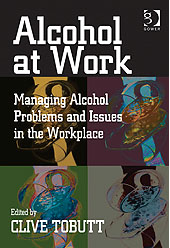Alcohol at Work; Managing Alcohol Problems and Issues in the Workplace

Tobutt C (2010)
Reviewer: Richard R. T. Hill – H & S Manager Piot Construction
The cost to businesses of alcohol abuse at the workplace in the United Kingdom alone currently stands at circa UK pounds 2 billion per year. In purely financial terms this p requires effective redress by HR, occupational health and risk assessment managers, in addition to those involved in combatting alcohol abuse and/or addiction resulting in criminal behaviour such as theft, violence/abuse in the workplace and fraud. According to recent figures from the Health and Safety Executive (UK) 90% of HR directors from top UK organisations surveyed stated that alcohol consumption was a problem for their organisation. Most regarded alcohol as a fairly minor problem, involving a small number of employees. However, 17% of directors described alcohol consumption as a ‘major problem’ for their organisation.
Concerns of directors, in order of priority were:
- Loss of productivity and poor performance
- Lateness and absenteeism
- Safety concerns
- Effect on team morale and employee relations
- Bad behaviour or poor discipline
- Adverse effects on company image and customer relations
Alcohol-related absenteeism and sickness absence as alcohol is estimated to cause 3-5% of all absences from work; about 8 to 14 million lost working days in the UK each year.
The effects of drinking on productivity and safety as alcohol consumption may result in reduced work performance, damaged customer relations, and resentment among employees who have to ‘carry’ colleagues whose work declines because of their drinking. There are no precise figures on the number of workplace accidents where alcohol is a factor, but alcohol is known to affect judgment and physical co-ordination. It is important to note that drinking even small amounts of alcohol before or whilst carrying out safety sensitive work will inevitably increase the risk of an accident.
Contrary to popular belief, the majority of people who have a drinking problem are in work. The good news is that people with drink problems can and do cut down. There are places throughout the country where people with drinking problems can go for expert help. The prospect of tackling when and how much employees drink can be daunting, especially for businesses without a personnel specialist. But acting to prevent problems before they occur can save time in the end and is often more effective than dealing with a problem that has become too serious to ignore. This book provides a definitive guide to the problem, exploring its nature and scale and providing a complete range of ideas and techniques to help create a policy in the workplace and develop appropriate and effective measures for monitoring and tackling alcohol abuse. The key collective message is solve the problem by taking the alcohol not the person out of the workplace.
Clive Tobutt is a research associate at the Addictions Department, National Addiction Centre, King's College, University of London, UK. He is also a technical consultant to the United Nations Office on Drugs and Crime on the development of guidelines for UN Member States for preventing alcohol and drugs in workplaces.


